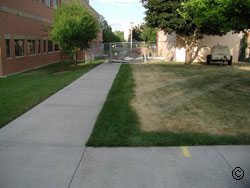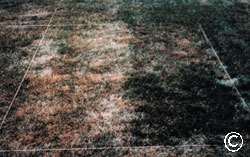If the average person was asked to give 10 reasons for local water shortages, there is little doubt that “Kentucky bluegrass” would be at or near the top of the list. It might seem that our water woes could be partially solved by simply eliminating this plant from our landscapes and using something else in its place.
Why is Kentucky bluegrass a beneficial choice for my lawn?

Astute observers learned a few things about Kentucky bluegrass during recent drought periods. First, it can remain green and healthy with far less water than most people ever thought possible. Second, it can survive well for extended periods of time without any irrigation due to its excellent dormancy mechanism.
How little can I water Kentucky bluegrass?
Others discovered what sod producers and the best golf course superintendents have always known – that bluegrass can do well with reduced amounts of water. Homeowners discovered that twice weekly watering restrictions would produce healthy bluegrass lawns. Even once weekly watering was adequate for all but the warmest summer periods. Many bluegrass lawns can survive weeks – even months – without any supplemental irrigation.
What is harmful to Kentucky bluegrass?
 Interestingly, more than a few tall fescue lawns were killed or thinned by the same watering restrictions under which bluegrass survived quite well. It is also true that while a large number of bluegrass lawns died or were found dead in the spring after extended dry periods. The majority of these dead lawns had been damaged by spider mites, not properly managed prior to the drought (poor mowing, fertilization, irrigation, and other cultural practices), or were planted in poorly prepared soil.
Interestingly, more than a few tall fescue lawns were killed or thinned by the same watering restrictions under which bluegrass survived quite well. It is also true that while a large number of bluegrass lawns died or were found dead in the spring after extended dry periods. The majority of these dead lawns had been damaged by spider mites, not properly managed prior to the drought (poor mowing, fertilization, irrigation, and other cultural practices), or were planted in poorly prepared soil.
Should I replace my Kentucky bluegrass if it’s dying?
Before replacing an otherwise healthy bluegrass lawn with an alternative grass, do research and talk to experts. This is especially relevant in communities that may restrict installation of new plant material. Bluegrass is still the best grass species for many of the places where it is now growing – and a drought resistant one at that!
For more information, see the following Colorado State University Extension fact sheet(s).
- Watering Established Lawns
- Lawn Care
- Fall and Winter Watering
- Renovating the Home Lawn
- Water Wise Tips for Colorado Landscapes
For more information, see the following Planttalk Colorado™ script(s).



